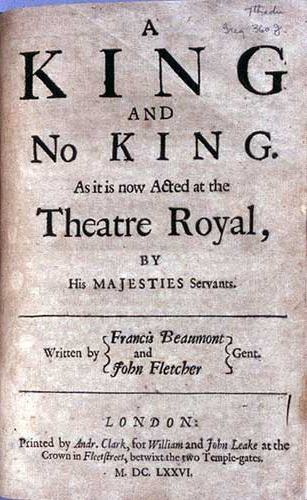Related Research Articles
Rollo Duke of Normandy, also known as The Bloody Brother, is a play written in collaboration by John Fletcher, Philip Massinger, Ben Jonson and George Chapman. The title character is the historical Viking duke of Normandy, Rollo. Scholars have disputed almost everything about the play; but it was probably written sometime in the 1612–24 era and later revised, perhaps in 1630 or after. In addition to the four writers cited above, the names of Nathan Field and Robert Daborne have been connected with the play by individual scholars.
Thomas Goffe (1591–1629) was a minor Jacobean dramatist.
Gerard Langbaine was an English dramatic biographer and critic, best known for his An Account of the English Dramatic Poets (1691), the earliest work to give biographical and critical information on the playwrights of English Renaissance theatre. He is sometimes called Junior or the Younger to distinguish him from his father (1609–58) of the same name, a Doctor of Divinity who was Provost of The Queen's College, Oxford (1646–58) and Keeper of the University Archives.
The Old Law, or A New Way to Please You is a seventeenth-century tragicomedy written by Thomas Middleton, William Rowley, and Philip Massinger. It was first published in 1656, but is generally thought to have been written about four decades earlier.
Humphrey Moseley was a prominent London publisher and bookseller in the middle seventeenth century.

The Maid's Metamorphosis is a late Elizabethan stage play, a pastoral first published in 1600. The play, "a comedy of considerable merit," was published anonymously, and its authorship has been a long-standing point of dispute among scholars.
The Sun's Darling is a masque, or masque-like play, written by John Ford and Thomas Dekker, and first published in 1656.
Cupid's Revenge is a Jacobean tragedy written by Francis Beaumont and John Fletcher. It was a popular success that influenced subsequent works by other authors.
The Faithful Shepherdess is a Jacobean era stage play, the work that inaugurated the playwriting career of John Fletcher. Though the initial production was a failure with its audience, the printed text that followed proved significant, in that it contained Fletcher's influential definition of tragicomedy. Like many of Fletcher's later tragicomedies, The Faithful Shepherdess deals with the darker side of sexuality and sexual jealousy, albeit within a comic framework.

Philaster, or Love Lies a-Bleeding is an early Jacobean era stage play, a tragicomedy written by Francis Beaumont and John Fletcher. One of the duo's earliest successes, the play helped to establish the trend for tragicomedy that was a powerful influence in early Stuart-era drama.
The Atheist's Tragedy, or the Honest Man's Revenge is a Jacobean-era stage play, a tragedy written by Cyril Tourneur and first published in 1611. It is the only dramatic work recognised by the consensus of modern scholarship as the undisputed work of Tourneur, "one of the more shadowy figures of Renaissance drama."
The Elder Brother is an early seventeenth-century English stage play, a comedy written by John Fletcher and Philip Massinger. Apparently dating from 1625, it may have been the last play Fletcher worked on before his August 1625 death.
The Poor Man's Comfort is a Jacobean era stage play, a tragicomedy by Robert Daborne — one of his two extant plays.
Aglaura is a late Caroline era stage play, written by Sir John Suckling. Several aspects of the play have led critics to treat it as a key development and a marker of the final decadent phase of English Renaissance drama.

A King and No King is a Jacobean era stage play, a tragicomedy written by Francis Beaumont and John Fletcher and first published in 1619. It has traditionally been among the most highly praised and popular works in the canon of Fletcher and his collaborators.

The Scornful Lady is a Jacobean era stage play, a comedy written by Francis Beaumont and John Fletcher, and first published in 1616, the year of Beaumont's death. It was one of the pair's most popular, often revived, and frequently reprinted works.
Richard Meighen was a London publisher of the Jacobean and Caroline eras. He is noted for his publications of plays of English Renaissance drama; he published the second Ben Jonson folio of 1640/41, and was a member of the syndicate that issued the Second Folio of Shakespeare's collected plays in 1632.
Thomas Walkley was a London publisher and bookseller in the early and middle seventeenth century. He is noted for publishing a range of significant texts in English Renaissance drama, "and much other interesting literature."
The Insatiate Countess is an early Jacobean era stage play, a tragedy first published in 1613. The play is a problematic element in John Marston's dramatic canon.

Augustine Matthews was a printer in London in the Jacobean and Caroline eras. Among a wide variety of other work, Matthews printed notable texts in English Renaissance drama.
References
- ↑ William Marvel Nevin, Lectures on the History of English Literature, Lancaster, PA, Intelligencer, 1895; p. 223.
- ↑ William John Lawrence, "The Authorship of The Careless Shepherdess," The Times Literary Supplement, July 24, 1924.
- ↑ Norbert F. O'Donnell, "The Authorship of The Careless Shepherdess," Philological Quarterly Vol. 33 (1954), pp. 43-7.
- ↑ Felix Emmanuel Schelling, Elizabethan Drama 1558–1642, Boston, Houghton Mifflin, 1908; Vol. 2, p. 169.
- ↑ David Scott Kastan, "Performances and playbooks: the closing of the theatres and the politics of drama," in Kevin M. Sharpe and Steven N. Zicker, eds., Reading, Society, and Politics in Early Modern England, Cambridge, Cambridge University Press, 2003; p. 175.
- ↑ Andrew Gurr, The Shakespearean Playing Companies, Cambridge, Cambridge University Press, 2004, p. 214.
- ↑ Alexander Leggatt, Jacobean Public Theatre, London, Routledge, 1992, p. 95.
- ↑ William John Lawrence, Speeding Up Shakespeare, London, Argonaut Press, 1937; pp. 185-6.